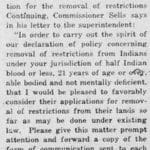Osage and Quapaw Get Their Freedom by Sells’ Order
August 21, 1919
The Pawhuska Capital
Microfilm Roll: MN00329
On this day in Osage country,
The Pawhuska Capital published an article describing Commissioner Sells’ proposal to remove some of the land allotment restrictions imposed on American Indians.
According to
The Encyclopedia of Oklahoma History and Culture allotment was “the federal policy of dividing communally held Indian tribal lands into individually owned private property [and] the culmination of American attempts to destroy tribes and their governments.” According to the article, existing legislation, created in 1917, allowed for the removal of restrictions from the allotments as long as the petitioner, himself, requested the action be done and was declared “mentally competent.” The petitioner also had to be “one-half or less Indian blood… [and] 21 years of age or over.”
Commissioner Cato Sells of the Bureau of Indian Affairs, proposed that the already existing legislation concerning the restrictions of allotted land be removed for the Osage and Quapaw tribes. As a result, the members of the two tribes gained more ownership over their lands and once the restrictions were lifted, the land became subject to taxation. This is not to say, however, that this was done without future repercussions, including the loss of tribal lands.
Morgan M. Guzman
“Osage and Quapaw Indians get their Freedom by Sells’ Order.”
The Pawhuska Capital. August 21, 1919, p. 1. Microfilm roll number MN00329. Sequoyah National Research Center, Little Rock, Arkansas.
Further Reading
“An Act for the Removal of Restrictions from Part of the Lands of Allottees of the Five Civilized Tribes (1908).” Library of Congress.
https://www.loc.gov/law/help/statutes-at-large/60th-congress/session-1/c60s1ch199.pdf Date accessed April 17, 2018.
Kidwell, Clara Sue. “Allotment.” The Encyclopedia of Oklahoma History and Culture.
http://www.okhistory.org/publications/enc/entry.php?entryname=ALLOTMENT Date accessed April 16, 2018.
Ringold, A. F. “Indian Land Law—Some Fundamental Concepts for the Title Examiner.” Tulsa Law Review 10, no. 3 (1975): 321-338.
Source File(s)
Related Stories
Related Topics
View more stories in
Tags:


